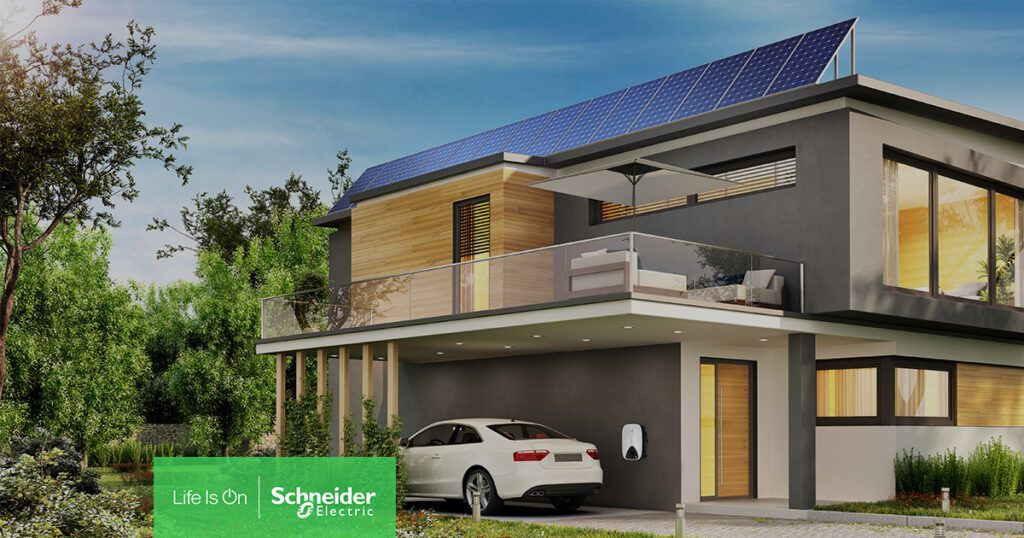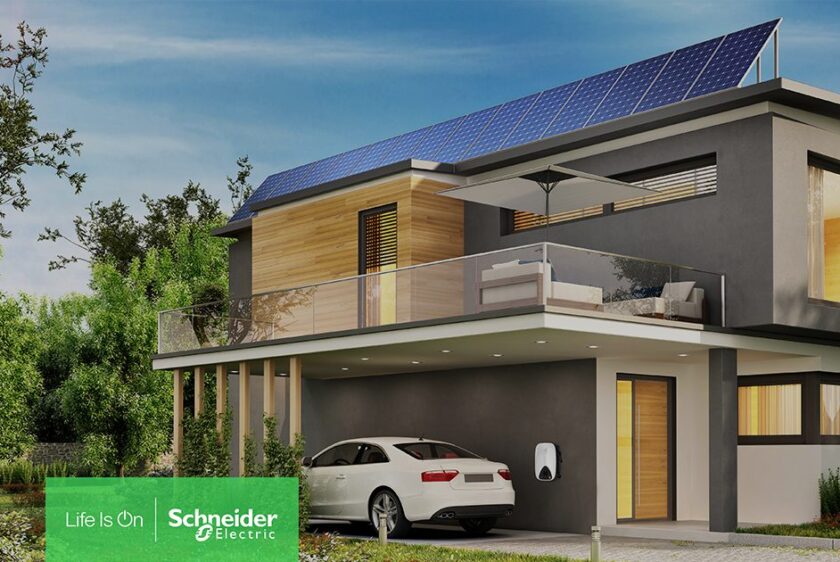This audio was created using Microsoft Azure Speech Services
Driving an electric car, even one running on electricity derived from fossil fuels, is better for the environment than cars with internal combustion engines (ICE). The Wall Street Journal demonstrated that, from cradle to grave, the production and operation of electric cars emits less CO2 than ICE vehicles. But the full benefit of electric vehicle (EV) adoption won’t be realized until clean, renewable electricity is the primary fuel; something possible today using energy management systems for residences with smart home EV charging. Luckily, the more electric cars we get on the road, the faster we’ll arrive at our renewable energy destination.
The most common renewable energy sources – solar and wind – are intermittent. Increasing production to meet demand cannot be done at will. Large-scale battery storage is not yet sufficient, and transmission across great distances is a challenge. The growing number of electric cars dotting our roads and highways need more electricity to make them go. To mitigate these challenges, we need more renewable generation, and we need it closer to where it will be used. For an increasing number of electric car owners, both generation and consumption are done in one place: at home.
The home EV charging and solar connection
CleanTechnica found in a survey that 38% of EV drivers in North America had solar panels on their homes. When compared to the just 8% of U.S. homeowners who currently have residential solar, there is a clear link between owning an electric car and generating solar energy.
These results are intuitive. Electric cars can still be expensive, and the first wave of adopters are more likely to own homes. Falling battery prices coupled with government subsidies ease the financial burden for some consumers, but we have not yet reached price parity with ICE cars. Since public charging is still relatively scarce, home EV charging is the trend.
Different research show that both U.S. and European drivers consider environmental concerns as the chief motivator when switching to EVs, outweighing financial perks. In fact, a majority of drivers in both the U.S. and U.K. say owning an electric car inspired green behavior off the road, suggesting EVs are a gateway to energy efficiency.

Distributed renewables accelerate energy transition
Residential solar proliferation is instrumental in solving some of our most pressing energy issues. Governments and utilities alike have an interest in fostering its growth. The goal of a functioning electric grid is for electricity to be available when it is needed, literally at the flip of a switch. This requires a constant balance of supply and demand. An unexpected surge in demand – say from a winter storm – requires a sudden and matching swell of supply. Because solar is intermittent, utilities rely on “dispatchable” energy like natural gas in a pinch. But more solar panels distributed throughout the utility’s area provide flexibility.
Distributed energy resources (DERs) like solar are pivotal in transitioning to renewable energy. A study by Vibrant Clean Energy found that wide deployment of DERs, coupled with utility-scale renewable energy, was the least costly and most effective path to reaching long term climate goals in the U.S. In parallel, massive and fast deployment of renewable energy is at the core of the REPowerEU plan, to become energy independent from fossil fuels.
Homes with solar rely less on the electricity running through the grid, so when supply is lacking for one reason or another, fewer homes are competing for scarce electrons. And if those homes are connected to the grid, utilities can move excess electricity to homes without solar panels. Distributing solar panels across many homes creates production and transmission nodes that utilities can leverage to improve grid performance.
Transmission is simpler at shorter distances, so moving electricity within a neighborhood is easier than pulling from a faraway plant. A failure in one power line results in electricity being re-routed through another. More solar panels living closer to these potential points of failure increase utility agility. More agility means fewer outages and less need for costly infrastructure to “firm” the system. With artificial intelligence, utilities can seamlessly monitor and manipulate energy from DERs without impacting homeowners.
Energy storage on wheels
One of the challenges of renewable energy is storage. To utilize each drop of electricity produced by solar, batteries are needed to store energy so it can be consumed on cloudy days or at night. Electric cars are batteries on wheels, and more electric cars and home EV charging means more storage to be tapped.
EV owners can store electricity in their cars that can connect with their homes and one day soon to the grid. The International Renewable Energy Agency found that EV batteries connected to the grid could solve the renewable energy storage puzzle in the next 30 years. Older EV batteries that are no longer suitable for cars can be repurposed as distributed storage resources. And electric car owners who are more likely to install solar in their homes are also more likely to have additional residential battery systems.
Charting the course
More electric vehicles on the road means less carbon spewing into the atmosphere. When powered by clean energy, the benefits multiply. Many governments and automakers have signaled their commitment to accelerating EV adoption. Utilities should also encourage EV ownership and work with consumers to simplify the process, remove barriers and tout the synergies of EVs and solar panels.
The road to a renewable energy future will be bumpy, and navigation will take time, coordination, innovation, and will be replete with tough challenges. We can expect a few twists and turns, but we know where we’re headed. Electric cars can help us get there.
—
To know more:

Visit Schneider Home.
Visit eMobility solutions.
About the author

Ashley Horvat, VP eMobility NAM
Ashley Horvat serves as leader of Schneider Electric’s North American eMobility Hub, responsible for full P&L of the eMobility business unit, which includes R&D, Marketing, and Sales teams. She spearheads the EV strategy, business plan, full charging offer, deployment execution and business performance, and the oversight of a team of eMobility experts driving innovation throughout North America in charging hardware, software, power distribution, and energy management. She began her career in the public sector where she worked at DOT, DOE, and as Chief EV Officer, where she worked nationwide on ZEV state initiatives. Horvat forged a path working for EV industry startups as an early-stage employee, scaling the orgs through to M&A stage at PlugShare (Innogy Acquisition) and Greenlots (Royal Dutch Shell Acquisition).



